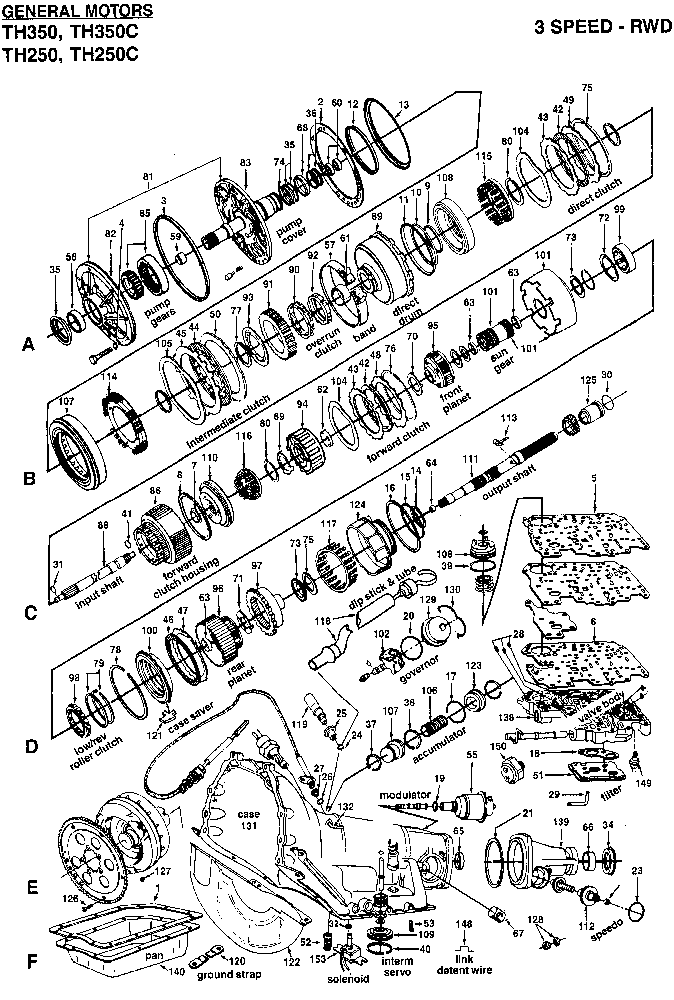
To ensure this, there are several methods you can use to determine the correct placement of the transmission line. When it comes to transmission lines, it is important to know which line goes where so that the system works properly and efficiently. As with most automotive components, proper maintenance and repair will go a long way towards keeping your TH350 functioning optimally – so make sure you take time periodically inspect all lines connected to this important piece of equipment! How Do You Know Which Transmission Line Goes Where? Generally speaking, however, you’ll want to ensure that this line is running away from any heat sources such as exhaust pipes or manifolds otherwise you risk burning out your system due to excessive heat exposure.
#TURBO 350 TRANSMISSION DIAGRAM MANUAL#
To avoid any confusion, it helps to check your vehicle manual for specific instructions regarding where this line should run in order for it to function properly. The return line carries hot fluid from the transmission back to where it can be cooled and reused. It’s usually a rubber hose that runs from the bottom of the transmission to either an external cooler or directly into your vehicle’s radiator.

The return line on the TH350 transmission is typically located at the rear of the transmission, but may be located elsewhere in some vehicles. Knowing what the different parts do can also help prevent issues from arising in the first place, so it pays to get familiar with this information!Ĭredit: Which Line is the Return Line on the Th350? The diagrams are typically available on the manufacturer’s website or in your owner’s manual, so be sure to consult those resources if needed. A transmission cooler line diagram is an important part of understanding how your vehicle’s cooling system works and can help identify potential problems before they become serious. If you’re looking for a Chevy transmission cooler lines diagram, you’ve come to the right place. It is important to properly diagnose any issues with your transmission before attempting to adjust the cooler line pressure as incorrect settings can lead to further problems down the road. This pressure helps to keep the fluid temperature steady and also prevents damage to the internal components of the transmission due to extreme wear or heat. The cooler line pressure on a TH350 transmission is typically set between 40 and 50 PSI.
#TURBO 350 TRANSMISSION DIAGRAM INSTALL#
With this information, you should be able to confidently install and maintain your own turbo 350 transmission cooler lines with ease! TH350 Transmission Cooler Lines and linkage problems. We’ll also discuss why it’s important to have them in your vehicle in the first place. Here we will provide an overview of how these lines are installed and connected, as well as tips on how best to maintain them.

If you’re looking for a Turbo 350 transmission cooler lines diagram, then you’ve come to the right place. The diagram should also include any additional hoses that connect directly to either side of these two main components for added protection against overheating and wear caused by extreme conditions. There are two types of coolers: external and internal.Įxternal coolers use air to remove heat from engine oil before it enters the transmission while internal coolers utilize a radiator or other type of heat exchanger to reduce temperatures inside the assembly itself The Turbo 350 uses both an external cooler line routed from a thermostat on top of the radiator, as well as an internal cooler within its own housing. The diagram will usually have a schematic that shows all of the components in the system, including the lines going to and from each component. Turbo 350 transmission cooler lines diagrams show the flow of fluid through the transmission cooling system.


 0 kommentar(er)
0 kommentar(er)
